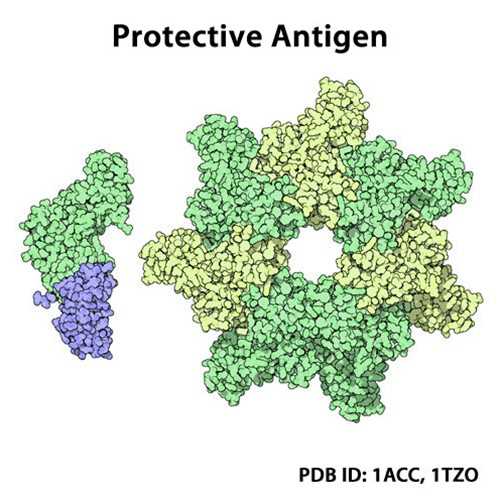PA K563C (Anthrax Protective Mutant Antigen (PA-K563C))
K563 is on the outside surface of protective antigen (PA) and of the PA oligomer. Modification of this residue does not interfere with oligomer formation or activity. The Cysteine added here provides a convenient target for attachment of dyes, etc., using maleimide or iodoacetyl reactive groups to react with the cysteine. Native PA contains no other cysteines.
Anthrax toxin is a three-protein exotoxin secreted by virulent strains of the bacterium, Bacillus anthracis, the causative agent of anthrax. Anthrax toxin is composed of a cell-binding protein, known as protective antigen (PA), and two enzyme components, called edema factor (EF) and lethal factor (LF). Anthrax is caused by B. anthracis, a spore-forming, Gram positive, rod-shaped bacterium. The lethality of the disease is caused by the bacterium's two principal virulence factors: the polyglutamic acid capsule, which is anti-phagocytic, and the tripartite protein toxin, called anthrax toxin.
From the laboratory of Stephen H. Leppla, PhD, National Institute of Allergy and Infectious Diseases/NIH.
K563 is on the outside surface of protective antigen (PA) and of the PA oligomer. Modification of this residue does not interfere with oligomer formation or activity. The Cysteine added here provides a convenient target for attachment of dyes, etc., using maleimide or iodoacetyl reactive groups to react with the cysteine. Native PA contains no other cysteines.
Anthrax toxin is a three-protein exotoxin secreted by virulent strains of the bacterium, Bacillus anthracis, the causative agent of anthrax. Anthrax toxin is composed of a cell-binding protein, known as protective antigen (PA), and two enzyme components, called edema factor (EF) and lethal factor (LF). Anthrax is caused by B. anthracis, a spore-forming, Gram positive, rod-shaped bacterium. The lethality of the disease is caused by the bacterium's two principal virulence factors: the polyglutamic acid capsule, which is anti-phagocytic, and the tripartite protein toxin, called anthrax toxin.
From the laboratory of Stephen H. Leppla, PhD, National Institute of Allergy and Infectious Diseases/NIH.
In order to purchase this product, we require a Letter of Assurance form to be completed. Download form here: ![]() Kerafast Letter of Assurance
Kerafast Letter of Assurance
| Product Type: | Protein |
| Name: | K563C |
| Alternative Name(s): | PA K563C |
| Accession ID: | P13423 |
| Strain: | Expressed in avirulent engineered B. anthracisstrain BH450 |
| Format: | Purified protein (liquid) |
| Purity: | Hydroxyapatite Chromatography |
| Buffer: | 5 mM HEPES pH 7.5 and 0.5 mM EDTA, 0.25 mM DTT |
| Concentration: | 4.68mg/mL |
| Storage: | -80C |
| Shipped: | Dry ice |
- Leppla SH. Production and purification of anthrax toxin. Methods Enzymol. 1988;165:103-16.
- Bradley, K. A., Mogridge, J., Mourez, M., Collier, R. J., and Young, J. A. (2001) Identification of the cellular receptor for anthrax toxin. Nature 414, 225-229
- Christensen, K. A., Krantz, B. A., and Collier, R. J. (2006) Assembly and disassembly kinetics of anthrax toxin complexes. Biochemistry 45, 2380-2386
If you publish research with this product, please let us know so we can cite your paper.


